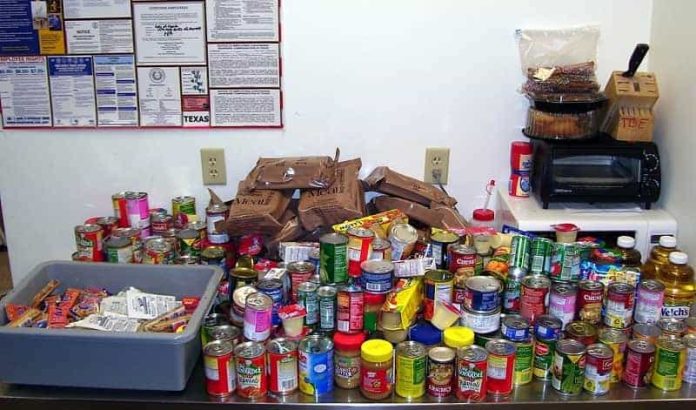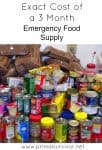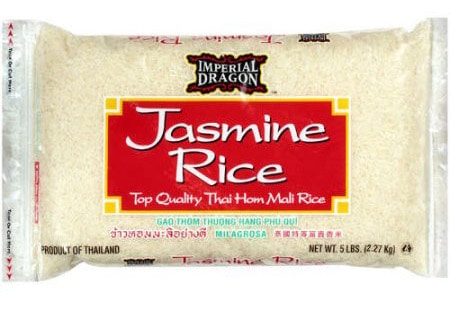I’m not going to lie or sugarcoat things. Preparing for a disaster does require money. However, it probably doesn’t cost as much as you think.
There are three main ways that you can go about stockpiling emergency food:
- Buy instant meals from the supermarket
- Buy non-perishable goods (dry staples and canned) from the supermarket
- Buy food buckets with Meals Ready to Eat (MREs)
Here I will break down the costs of each approach and their pros/cons so you can get started!
Option 1: Store-Bought Instant Meals
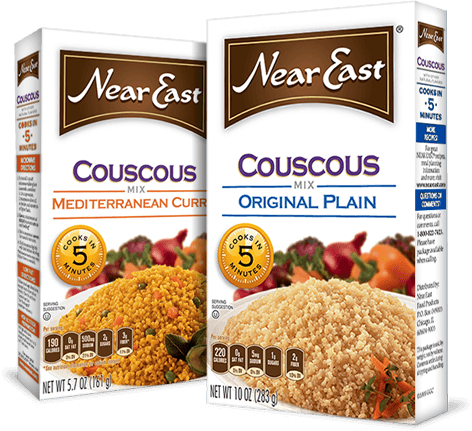
This is the easiest way to start building up your emergency food supplies. You can just buy a bit extra at the supermarket each time you go. It is also the most straightforward and relatively cheap way to get prepped.
But there are a lot of downsides to using instant meals as your emergency food. These foods are loaded with sodium and VERY unhealthy. You won’t get the nutrients you need to stay healthy through the disaster.
Also, note that YOU MUST REPACKAGE BOXED FOODS.
Some foods (like the packages in the pic above) might be okay, but boxes of food (such as mac n’ cheese) will get ruined. Think of all those food boxes soaked during a flood or smashed open during an earthquake!
I’ll talk more about this in the next section.
Example Foods
- Poptarts: 200 calories each, $0.25 each
- Oatmeal Packets: 160 calories per packet, $0.20 per packet
- Breakfast Bars: 130 calories each, $0.30 per bar
- Granola Bars: 100 calories each, 0.40 cents per bar
- Boxes of Cereal: 100 calories per serving, $0.20 per serving
- Canned Soups and Stews: 350-500 calories per can; $1.50-$2.50 per can
- Mac and Cheese Boxes: 500 calories per serving, $1.25 per serving
- Parmesan Couscous Mix: 200 calories per serving, $0.70 per serving
Serving sizes are pretty small on these products. You’d have to eat a bunch of servings to get anywhere near enough calories per day.
So, here are a few examples of what you might expect to eat during a day.
Emergency Meal Day 1:
- 2 PopTarts (400 calories): $0.50
- 20oz canned beef stew (500 calories): $2.00
- ½ box of Mac and Cheese (540 calories): $1.25
=$3.75 per day per person
Emergency Meal Day 2:
- 2 instant oatmeal packets (360 calories): $0.40
- 20 oz can of lentil soup (440 calories): $2.00
- ½ box of instant rice and beans (570 calories): $1.20
- 2 granola bars (200 calories): $0.80
=$4.40 per day per person
Emergency Meal Day 3:
- 2 breakfast bars (250 calories): $0.80
- 10 oz can tomato soup (225 calories): $0.90
- Prego Ready Meals Alfredo (370 calories): $2.00
- 5 peanut butter cookies (650 calories): $1.20
=$4.90 per day per person
TOTAL COST FOR 90 DAYS: $1,350-$1,764 (for a family of 4)
Option 2: Shelf-Stable Staples (Canned and Dry)
This is what a lot of hardcore, industrious preppers do. They carefully calculate what their family needs to survive for 3 months (or longer) – including calories and nutritional requirements – and then gather everything up.
These foods need to be stored properly. When done right, the emergency foods can last a very long time – up to 20 years.
Note that I’ve included canned and dry staples here. Some people only buy canned foods. But, seriously, have you ever tried eating green beans straight from the can? Yuck! Eating just canned food tastes like crap. But put them on some instant mashed potatoes made with dry milk and seasonings, and you’re good to go.
Alternatively, you can get buckets of freeze-dried veggies and fruits. These taste a LOT better than the canned stuff. If you buy them in bulk, it is a lot cheaper. The bucket linked contains 165 servings of freeze-dried veggies.
You MUST Repackage Dry Staples!!!
You can’t just buy a bunch of bags of rice and consider yourself set for grains!
Unless you are continuously rotating through your supplies (which is hard when you’ve got that much), your dry foods will start to spoil.
Yes, moisture can get through that plastic packaging.
For long-term storage of dry goods (rice, dry beans, dry fruit, etc.), YOU MUST SEAL THE FOOD. The easiest and cheapest way to do this is to buy mylar bags and oxygen absorbers.
Each food goes into its own mylar bag; almost all the air is pushed out of it, then you put some oxygen absorbers in there before sealing the mylar bag. After that, you put the mylar bags into 5-gallon buckets.
Recommended Reading:
The mylar bags protect the food against moisture and air spoilage. The buckets protect against pests and damage, such as during flooding.
I prefer to use 1-gallon mylar bags instead of larger bags. This makes it easier to access your emergency food. If you need to get to it, you only have to open a small bag instead of opening up your entire supply and exposing it to spoilage.
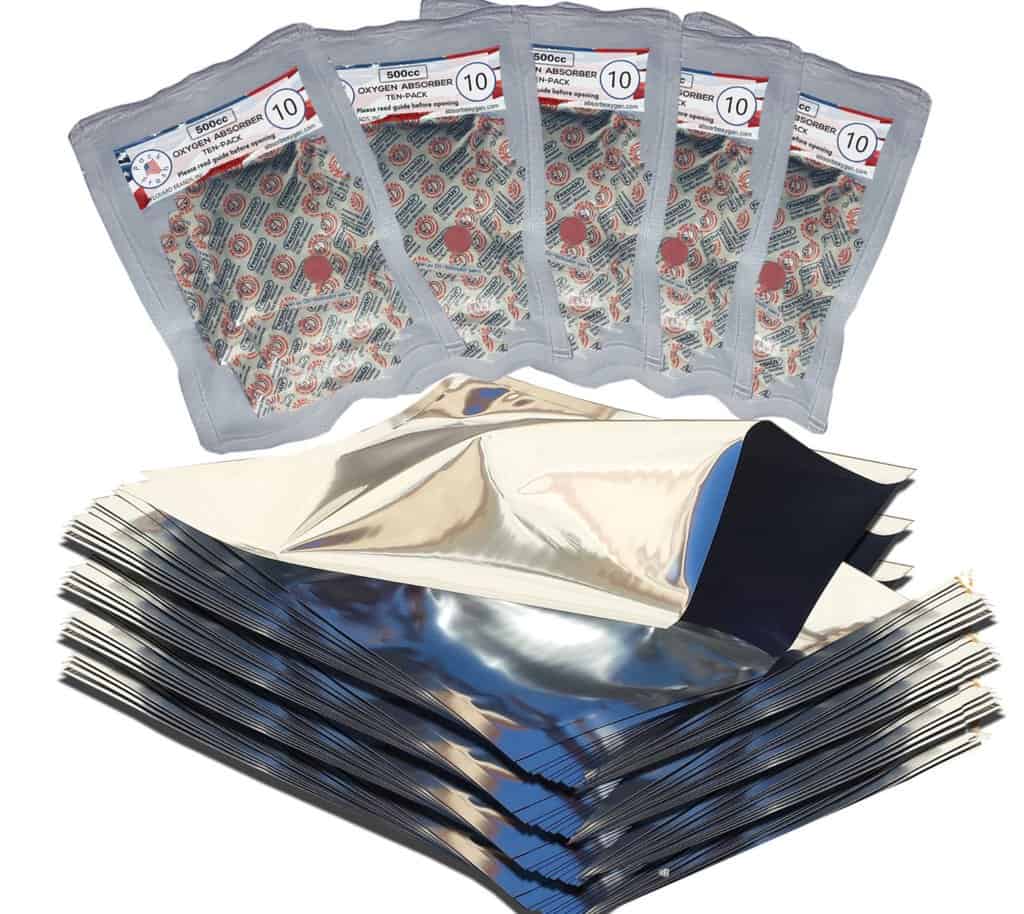
What Staples to Buy?
It is necessary to stock up on a variety of foods. Below I’ve listed the foods by group and how many servings per day you need (as recommended by Health.gov for a 1600-calorie diet).
- Grains (6 servings per day): Oats, barely, rice, canned yams, flour
- Veggies (3 servings per day): Canned peas, canned and dried tomatoes, canned corn, dried peppers, canned olives, canned carrots, canned and dried mushrooms, canned green beans, canned water chestnuts, canned asparagus, canned okra
- Fruits (2 servings per day): Canned or dried fruits like cherries, peaches, pineapple, cranberries, raisins, prunes
- Dairy (2-3 servings per day): Dry milk, canned milk
- Proteins (2 servings): Dry and canned beans, chickpeas, lentils, canned tuna, canned beef, spam, dried eggs, nuts, seeds, jerky, peanut butter
- Oils and Fats (2 servings): Olive oil, coconut oil, canola oil
How Much Do You Need to Buy?
It is difficult to figure out how much emergency food to buy because serving sizes are confusing. I’ve made a chart below with typical serving sizes to simplify things.
I also looked at the typical costs of things. There is a big range. A can of tuna costs just $1, whereas 2/3 cup of almonds can cost twice that. I did my best to calculate the average costs of each type of food so you can get an accurate estimate of the costs.
| Food | Servings per day | Serving Size | Total (per day) | Total Calories | Cost (per day) |
|---|---|---|---|---|---|
| Grains | 6 | Half cup cooked | 3 cups | 600 | $0.10 – $0.50 |
| Veggies | 3 | Half cup canned | 1.75 cups | 60 | $0.50 |
| Fruits | 2 | Half cup canned | 1 cup | 150 – 300 | $1.00 |
| Dairy | 3 | 1 cup milk from powder | 2-3 cups | 240 – 360 | $0.90 |
| Proteins | 2 | 2-3oz meat. Half cup beans, 1 cup nuts\seeds | 1 can tuna and half cup beans OR 2oz beef jerky and half cup nuts | 170 – 600 | $2.00 – $5.00 |
| Oils\Fats | 2 | 1 tsp vegetable oil | 2 tsp oil | 80 | $0.06 |
| Totals | 1300 – 2000 | $4.56 – $7.96 per day, per person |
How Much Food Total for 90 Days?
- Grains: About 30-40 pounds of grains per person
- Veggies: About 90 cans per person
- Fruits: About 60 cans per person
- Dairy: About 34lbs of dry milk powder per person, to reconstitute into 225 cups per person
- Proteins: About 45 cans of tuna and 15 cans of beans and 45oz beef jerky, and 38 cups nuts/seeds (11.5lbs) per person
- Oils: 1-quart olive oil and 14oz coconut oil
- Other: Sugar, honey, salt, herbs, spices
If you need more help with this, check out our inventory planner tool. It calculates calorie needs and serving amounts for each food group based on the number of family members.
Emergency Meal Plan Examples
Here are some examples of what you might eat using these staples as your emergency food.
Day 1
- Breakfast: 1 cup of oats, ½ cup of dried fruit
- Snack: 1 cup of milk
- Lunch: 1 can of tuna, ½ cup of asparagus, 1 cup of milk
- Snack: 2 Tbsp peanut butter
- Dinner: 2 cups pasta with olive oil drizzle, ½ cup mushrooms, ½ cup tomato sauce
Day 2
- Breakfast: 1 cup oats, 2/3 cup mixed nuts, 1 cup milk
- Snack: 1 cup of canned fruit
- Lunch: 1 cup of instant mashed potatoes made with 1 serving of powdered milk and 1 cup of peas
- Dinner:1 cup rice make with oil, 1/2 cup salsa, ½ cup beans
TOTAL COST FOR 90 DAYS: $1,680-$2,865 (for a family of 4)*
*Includes the cost of mylar bags and buckets.
Option 3: Emergency Food Buckets (MREs in a Bucket)
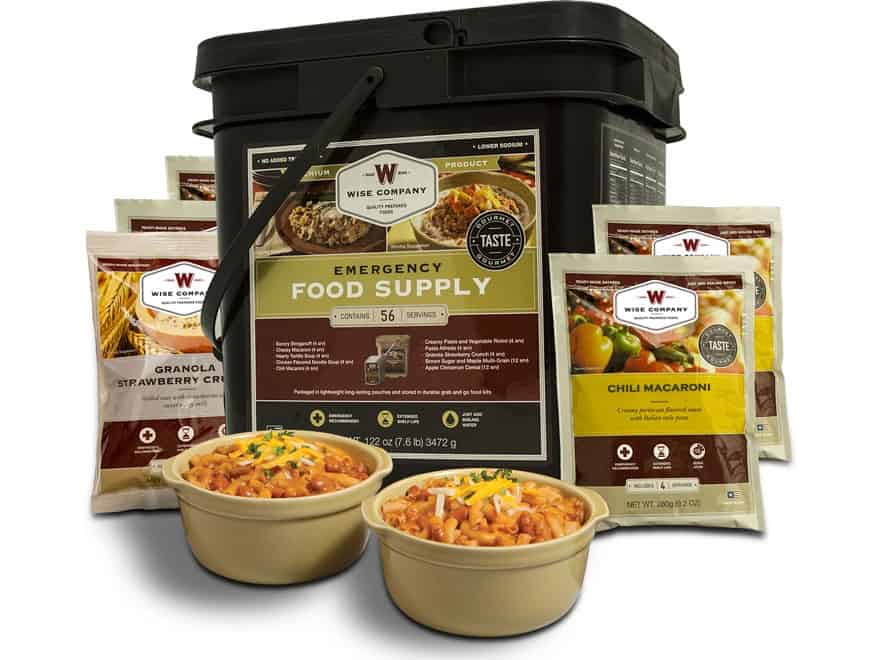
Meals Ready to Eat (MREs) are also known as “camping food.” This is the priciest route for emergency food, but it is also the easiest and safest.
The meals are already measured and packaged, so you don’t have to worry about spoiling or getting infested by pests.
This is the best option if you don’t want to worry about repackaging food for long-term storage!
Oh, and they taste good! I spent a trial week mainly eating canned food and was miserable. Most MREs come in tasty flavors.
Another benefit of buying MREs is that they cook quickly. Add some hot water to the pouch, let it sit for a few minutes, and you have a nutritious meal.
If you are interested in learning more about the best brands, check out our in-depth guide to the best emergency food.
TOTAL COST FOR 90 DAYS: $2,600 (for a family of 4)
Which Emergency Food Option is Best?
Option 1: Instant Meals
Total Cost (4 people for 90 days)= $1,350-$1,764
Option 2: Canned and Dry Staples
Total Cost (4 people for 90 days)= $1,680-$2,865
Can choose whatever foods you like best
Can be very healthy
Option 3: Emergency Food Bucket
Total Cost (4 people for 90 days)= $2,600
Priciest option
You might not like some of the flavors
What Do I Recommend?
Most preppers use a combination of all of these methods for their emergency food supply.
For example, they buy a smaller MRE food bucket and also stockpile some instant meals, canned goods, and granola bars. Just don’t forget to repackage those boxed instant meals, or they will get destroyed by pests, flooding, or spoilage!
The variety of food means that you are set for multiple types of disaster situations, such as when you need to grab a food bar and go or when you are hunkering down through a disaster and want a nutritious meal.

